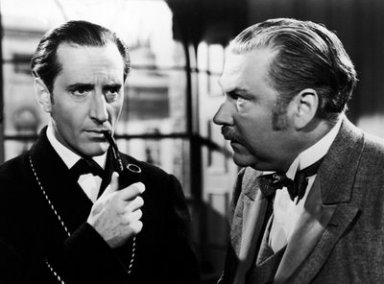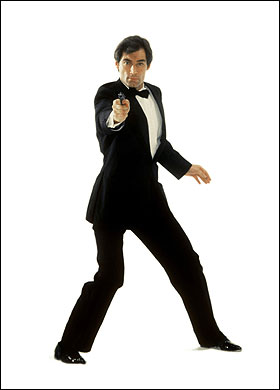|
Sherlock Bond
James Bond: Did He Really Live Twice? was written by John Bryan and
published in 1988. This is a strange but interesting (and little known)
book that puts forth the theory that James Bond is basically an updated
version of Sherlock Holmes and argues that the two characters have much
more in common than one would think at first glance. 'It has been
suggested and no doubt quite rightly,' begins Bryan. 'That James Bond
is the greatest fictional sleuth since Sherlock Holmes. But it is just
conceivable that not only is he the greatest fictional sleuth since
Sherlock Holmes but that he is to a considerable extent the greatest
fictional sleuth precisely because of Sherlock Holmes and that his
character and the adventures in which he becomes involved represent in
many ways the transposition of Sherlock Holmes in the latter part of
the Twentieth Century.' Bryan sets out his theory over the next 140 or
so pages and while you may or may not agree with some of his
conclusions it's a modestly fun read for anyone interested in these two
mythic fictional characters.
Bryan looks at several areas in which he believes there are
similarities between the two heroes. Plot similarities in the books,
weapons, villains and so on. He begins with physical similarities and
suggests that Fleming's description of Bond as 'lean, dark and
clean-cut' also fits the early Paget illustrations of Sherlock Holmes.
He then writes that Basil Rathbone (who was probably responsible for
the best known interpretation of Holmes in a series of films) and
Timothy Dalton (who lest we forget was James Bond when Bryan was
writing the book in the late eighties) also match this physical
criteria. According to Bryan, Dalton conforms very much to the Rathbone
mould and 'there can be no denying that the general pattern of the two
descriptions is such as to convey a remarkably similar overall
impression'. An obvious criticism here is that Bryan is selective in
which actors he compares as many people other than Rathbone have played
Holmes. Also, it's fine to compare the literary descriptions by Conan
Doyle and Fleming but when you start comparing a few actors who played
the characters it then becomes a bit pointless.

There is a chapter which looks at the villains both of these famous
characters battled - in Victorian London and the Cold War respectively
- which is quite good fun. This section looks at Professor Moriarty,
the great fictional nemesis of Holmes, and seeks to find similarities
between him and many of the villains in Ian Fleming's James Bond series
of novels. It's certainly true that Moriarty and the many urbane and
devious baddies in Fleming's world had a lot in common. One slight
criticism of this section of the book though is that Bryan doesn't
really spend enough time on Ernst Stavro Blofeld. Blofeld is the single
most famous villain created by Fleming and essentially James Bond's
version of Professor Moriarty. Holmes was such a famous and wonderful
creation you'd imagine the Conan Doyle books influenced many detective
books and fictional heroes in some form or other, Ian Fleming included.
All the same, it's probably stretching matters to argue that Bond was a
'reincarnation' of Holmes as the book often suggests. Bryan does point
out though that both Bond and Holmes have Scottish housekeepers in May
and Mrs Hudson!
The central thesis of James Bond: Did He Really Live Twice? goes most
wobbly when it moves onto the subject of women. 'If readers were asked
to compare the attitudes of Bond and Holmes towards women, his or her
initial reaction might well be to say - Well, it's quite simple really,
Bond can't leave them alone and Holmes wants nothing more than them to
leave him alone.' Bryan argues that the real fact of the matter is that
women can't leave Bond alone. He points out that Holmes was in love
with Irene Adler and so was not quite the ascetic cold fish he is
usually painted as and instead places his career and work before women
for fear that one who got too close would intrude on this. This is
something that James Bond does too suggests the book, once again
looking for similarities even in the unlikeliest of places. Bryan
weakens his case by bringing Basil Rathbone's Holmes into the equation
again, Rathbone's Great Detective certainly more amiable and tolerant
of woman than the Holmes of the book or some other portrayals.

Once again it doesn't really prove anything when you use an
interpretation of the character to support a theory rather than the
literary source and when it comes to women you'd imagine James Bond
probably has more in common with Mick Jagger than he does Sherlock
Holmes. Ultimately though, I think it doesn't really matter if Bond was
heavily influenced by Holmes or not. As a fan of both Sherlock Holmes
and James Bond it's generally just interesting to read various thoughts
about both of them in the same volume. 'On the face of it,' writes
Bryan. 'The reader may think you could hardly find two characters less
alike, but a closer examination does not in fact bear this out and
presents to us, rather, with some quite startling surprises.' I can't
say that Bryan ever really nails his case to the wall and delivers any
earth shattering piece of evidence but it's a new perspective on Bond
at least and not a bad read.
James Bond: Did He Really Live Twice? is a slightly curious book but
mildly intriguing and always readable (despite a few clunky sentences)
as it attempts to draw together the famous Victorian Detective and the
equally famous Secret Agent and present a the case that Bond is a mere
riff on Holmes, the same character dressed up in a new age and
occupation. At only 140 pages it isn't the most substantial read ever
but anyone interested in either James Bond or Sherlock Holmes would
probably be happy to end up with a copy of this on their bookshelf.
- Jake
c
2010
Alternative 007
|

|


